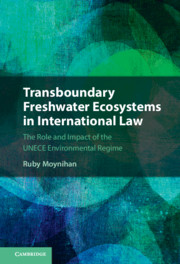 Transboundary Freshwater Ecosystems in International Law
Transboundary Freshwater Ecosystems in International Law Book contents
- Transboundary Freshwater Ecosystems in International Law
- Transboundary Freshwater Ecosystems in International Law
- Copyright page
- Dedication
- Epigraph
- Contents
- Figures
- Preface
- Acknowledgements
- Treaties and Other Instruments
- Table of Cases
- Abbreviations
- 1 The Role of International Law in Addressing the Global Freshwater Ecosystem Crisis
- 2 Conceptualising the UNECE Water and Environmental Regime
- 3 Contemporary Status of International Law on Transboundary Freshwater Ecosystems
- 4 The Common Normative Framework of the UNECE Environmental Regime and Its Contribution to International Water Law
- 5 An Ecosystem Approach in International Law Concerning Transboundary Freshwater Ecosystems
- 6 Public Participation
- 7 River Basin Organisations, Basin Agreements and European Environmental Law in the UNECE Regime
- 8 Transboundary Freshwater Ecosystems in International Law
- Bibliography
- Index
4 - The Common Normative Framework of the UNECE Environmental Regime and Its Contribution to International Water Law
Published online by Cambridge University Press: 01 October 2021
- Transboundary Freshwater Ecosystems in International Law
- Transboundary Freshwater Ecosystems in International Law
- Copyright page
- Dedication
- Epigraph
- Contents
- Figures
- Preface
- Acknowledgements
- Treaties and Other Instruments
- Table of Cases
- Abbreviations
- 1 The Role of International Law in Addressing the Global Freshwater Ecosystem Crisis
- 2 Conceptualising the UNECE Water and Environmental Regime
- 3 Contemporary Status of International Law on Transboundary Freshwater Ecosystems
- 4 The Common Normative Framework of the UNECE Environmental Regime and Its Contribution to International Water Law
- 5 An Ecosystem Approach in International Law Concerning Transboundary Freshwater Ecosystems
- 6 Public Participation
- 7 River Basin Organisations, Basin Agreements and European Environmental Law in the UNECE Regime
- 8 Transboundary Freshwater Ecosystems in International Law
- Bibliography
- Index
Summary
There is a pressing need to strengthen systemic integration and mutually supportive interpretation of norms and institutional coordination between the UNECE environmental agreements with a view to understanding their collective contribution to clarifying and further developing international water, environmental and general international law. This chapter identifies the contribution of the UNECE regime to established ‘central or cornerstone rules and principles’ of international water law, including the due diligence rule to avoid or mitigate transboundary harm, the duty to cooperate, the principle of equitable and reasonable use and transboundary environmental impact assessments (EIAs). Key findings demonstrate that these rules and principles are defined in greater detail in the UNECE treaties compared to global treaties, which fills gaps in international law. For example, the UNECE clarifies international law regarding transboundary EIAs by providing criteria to identify what level of risk triggers the obligation to conduct an EIA and compulsory minimum content of EIAs. The UNECE regime also clarifies the effect of applying general principles, like the precautionary and polluter pays principles to the ‘no harm’ rule which strengthens these obligations. The strengths and weaknesses of UNECE’s contribution to developing reporting mechanisms for the Sustainable Development Goals, especially SDG 6 on water, are discussed.
Keywords
- Type
- Chapter
- Information
- Transboundary Freshwater Ecosystems in International LawThe Role and Impact of the UNECE Environmental Regime, pp. 101 - 151Publisher: Cambridge University PressPrint publication year: 2021


